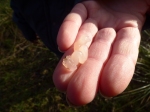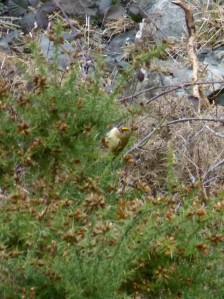Follow that Frit!
Who needs to jump in a taxi and have a car chase, when one can dash after butterflies on a nature reserve (and elsewhere)? Not me, that’s for sure!
The week began in Cambridge with a moth trap and Matt leaving for work, reminding to go through the moth trap before the wasps got it. I believe that my response just a grunted. I don’t really do communication when I’m still mostly asleep. Nonetheless, I managed to get up and go to the moth trap at a reasonable hour.
There were some absolute beauties in and around the trap – including my first (and second and third!) Swallow-tailed moths (Ourapteryx sambucaria). They really are gorgeous! I have been hoping to see one ever since I properly got into moths last year, particularly when my mother found one in the bathroom at their house. There was definitely some moth-jealousy going on that day (not helped by the fact that she had also recently seen two Jersey Tigers (Euplagia quadripunctaria) in the garden, and I hadn’t seen that species yet!).
A return to RSPB’s The Lodge was a lovely day out for me. Whilst Matt was busy doing his work stuff, I had a couple of meanders around the reserve – counting butterflies, watching wasps and generally having a nice time. I also met up with fellow AFON member, Lizzie Bruce, who has just started her new role as Warden for the Lodge. It was fabulous to finally meet her in person and we had a lovely chat about AFON, nature and, of course, the reserve.
I also took the opportunity to sit down and finish off working out my pan-species list! This is a list of all the species (across all taxon groups) that I have seen in the UK, from spiders to snakes, from lizards to leptidoptera. It has taken quite a while to go through all the groups, and I have to admit, I have left out bryozoans, mosses and lichens – because I honestly can’t remember which ones I have seen! So I am starting again with those. As of today (26/07/15) my list stands at 661 (661 = Common Toadflax, Linaria vulgaris), though I know that I have a couple of moths left to identify. In calculating my list, I have half-ticked off one of my 2015 Wildlife Resolutions! The other half being to set myself a target to reach by the end of 2015. It’s ok if I don’t reach the target, but the act of setting the target will tick off that resolution completely. Thus I am thinking that the 1k mark would be good one to aim for and break through. Can I reach 1000 species in the remaining 5 months? That’s around 15-16 species per week I think. You will just have to keep following my blog to find out!
Despite having ticked off the resolution to see 2 new butterfly species this year, and then seeing a couple more new species, I still wanted to try and see more. I am rather getting into this butterfly spotting lark! Though of course, to me, butterflies are basically moths, ha! I was tempted to try and see some hairstreaks species in some Cambridgeshire woodlands. We didn’t go to the reserve recommended by the local wildlife trust, but ended up stopping off at Gamlingay Wood on the commute home. It was such a wonderful stroll, examining flowers in the dappled sunlight and listening to the birdsong above.
Ambling down a woodland ride, I suddenly stopped. An orange butterfly! My inner pessimist said gloomily, “It’s probably a Comma” (not that there is anything wrong with a Comma of course). But wait, it had landed on a leaf some distance away … I quickly zoomed in with my camera, and then excitedly called to Matt: “It’s a Fritillary! And it’s not a Comma!!” With no butterfly guide to hand, I wasn’t sure of the species but luckily Matt knew it – a Silver-washed Fritillary (Argynnis paphia)! A lifer for me! And what a beautiful lifer to achieve! Such a large butterfly, and there were at least 6 of them flitting about and feeding on the bramble. At one point, two of them flew along the ride – one looping and circling around the other, a courtship ritual perhaps. I declare, I was so full of happiness then. There is something about butterflies, and in fact, nature as a whole, that enables me to forget my constant exhaustion and associated mild depression, which drag behind me every day.
Back at work and the rain had set in – just in time for a family activity at Lorton! Luckily the families who came along were up for heading out despite the weather. We didn’t have to go far, just across the track to the pond. Sheltering in the open barn, we dashed out every now and then to dip in the pond. The theme of the activity was dragonflies, so we were concentrating on the dragonfly and damselfly nymphs. However, we also caught a water stick insect (Ranatra linearis), which we don’t catch very often, and plenty of the usual suspects such as freshwater hoglouse (Asellus aquaticus) and whirligig beetle (Gyrinus substriatus). I made up a game off the hoof – each family had to replicate the movement of a dragon/damselfly nymph/adult, and the others had to guess what it was. It worked surprisingly well! Once we were thoroughly soaked through and pond dipped-out, we came in to dry off and for a cuppa, and some craft activities. Vicky had recently shown us a neat dragonfly craft activity and I showed the children (and parents) how to make it.
The kestrel chicks were unimpressed by the weather, spending the day fluffed up and huddling together, with only a couple of food drops from the parents! (NB, in the video you can only see two of the chicks, but there are still four) The kestrels can be viewed LIVE, but be quick if you want to watch them, I think they will fledge in the next week or so!
The kestrel chicks don't look impressed by today's rain! This weekend at Lorton, we will be celebrating birds with our Bird Bonzana Wild Weekend! If you can't join us, you can still celebrate our birds by watching the kestrels on our LIVE webcam, thanks to support from Dorset Tea!Bird Bonanza Wild Weekend: http://www.dorsetwildlifetrust.org.uk/bird-bonanza-wild-weekendKestrel webcam: http://www.dorsetwildlifetrust.org.uk/raptorcam.html~ Megan
Posted by Dorset Wildlife Trust on Friday, 24 July 2015
The weekend dawned clear and sunny, blue skies above and sunshine filling the reserve. After the day before, it was a welcome weather change. During the quiet moments, I popped outside to watch the butterflies. The reserve as a whole is superb for butterflies, but even just by the centre there are a couple of excellent spots. A large buddleia bush by the picnic benches, and a sunny patch of bramble just by the lane. Again, the very act of observing these creatures and being outside filled me with joy. I felt like my heart was going to burst out of my chest. Particularly when a Comma butterfly (Polygonia c-album) landed on me – I hardly dared breathe! Fortunately for my lungs, it darted off again after a couple of moments.
- ID tips: Note the orange on both the forewing and hindwings, plus two white spots in the black spot on the forewing
Taking advantage of the sunshine, with the knowledge that more rain was on its way for Sunday, I headed over to Portland after work. I wanted to visit somewhere new, the Perryfields Quarry, a nature reserve owned by Butterfly Conservation. A small but sweet little reserve, it was full of flowers and flutterings. A bit of breeze swept across the reserve, so the butterflies were keeping a low-profile. I still spotted a fair few as they rested in the grasses. No new lifers, or even year ticks, but I was happy nonetheless as I wandered about and photographed them. I’m repeating myself, but gosh I love having my camera back!
- Apparently we could see millions of them this summer as there have been loads in Europe … not seen all that many yet myself, but who knows what the rest of summer will bring!
- A nationally scare and UK BAP Priority species. Relatively common on Portland, but not in the UK
As the evening started to draw to a close and the sun sunk lower in the sky, I made my way to my usual Portland hangout – the Portland Bird Observatory of course! I do so love to spend a bit of time there, discussing recent wildlife sightings with staff and visitors. As you may remember, last week’s venture there resulted in directions to see a Puss Moth caterpillar (Cerura vinula)! This week it was advice on a good nearby spot for seeing the Grayling butterfly (Hipparchia semele) – a species I still haven’t seen despite spending plenty of time in the quarries. I went down to the advised spot, the eastern cliffs of the Isle, just below the lighthouse. However a chill was setting in, so I didn’t have much luck. Mind you, I saw plenty of birds and flowers, so I can’t complain. More so as I was joined by local naturalist and good friend, Sean Foote, who is a very useful person to have around as he can identify lots of things – resulting in two new plant species to add to my pan species list! Maybe soon I’ll be able to add Grayling to the list, or maybe I’m destined to forever dip it (i.e. miss it).
The postings on this site are my own and don’t necessarily represent Dorset Wildlife Trust’s positions, strategies or opinions (or any other organisation or individuals for that matter).




































































































































































































































































































